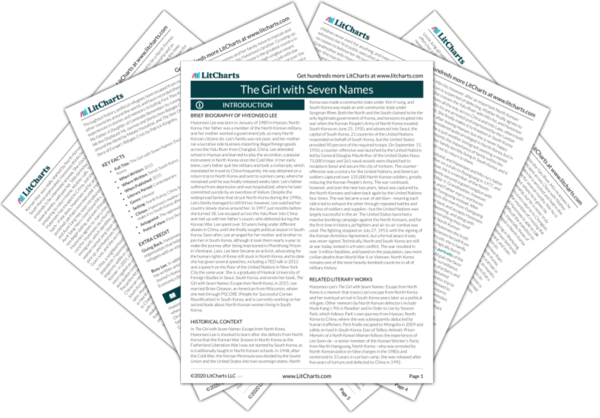Summary
Analysis
Hyeonseo’s family arrives in Anju in 1984. The city’s main industry is coal mining, and it is terribly polluted and frequently floods during the rainy season. There are only a few Soviet-style buildings in town, along with the requisite Kim Il-sung statue. Mother is distraught by this new city. She is used to privilege, but their life is still good. Father’s job allows them fish or meat with most meals—something most North Koreans only eat on the birthdays of the Leaders, when rations are increased.
The birthdays of Kim Il-sung, Kim Jong-il, and now, Kim Jong-un, are celebrated as national holidays in North Korea. Children are given presents and candy, and elaborate meals are eaten throughout the country. All major North Korean cities—and many smaller villages, for that matter—have statues of the Great Leaders, which again reflects the power of the Kim regime in North Korea.
Themes
Hyeonseo’s family lives on the military base, and in the middle of their new house is a wall-mounted speaker, which can’t be turned off or down. The speaker is used to broadcast announcements from the banjang, the head of the neighborhood unit. Banjangs are usually middle-aged women, who deliver warnings and spy on people for the government. On the day Hyeonseo’s family moves in, the banjang delivers them two portraits of the Leaders. The portraits are of the Great Leader, Kim Il-sung, and his son, the Dear Leader, Kim Jong-il.
The banjang and the wall-mounted speaker reflect the oppression of the people by the Kim regime. The watchful eye of the powerful regime can’t be escaped, not even in remote cities and villages. The idea of a speaker that screeches out warnings and intimidation invading one’s home and family life is unthinkable in other countries, but to North Koreans, it is completely normal.
Themes
The portraits must hang in all North Korean homes, and each home is issued a special white cloth with which to clean them. The cloth cannot be used to clean anything else, and the portraits must hang at the highest point in the home. Once a month, government officials wearing white gloves come to inspect the portraits and ensure they are clean and in compliance. Anyone found with dusty or crooked portraits is punished. Stories of heroic acts of portrait-saving are popular in North Korea, and every year on the birthdays of the Leaders, everyone lines up before the portraits and takes a long, deep bow.
Again, the portraits reflect the power of the Kim regime and the hold the regime has on the people to force their loyalty and respect. The idea of every home having the portraits and the image of millions of people bowing before them is a particularly strong image. Furthermore, the white-gloved officials tasked with ensuring compliance reflect the self-importance of the regime. The regime is so determined to be worshipped, they employ hundreds of men just to ensure that they are.
Themes
One week after arriving in Anju, Mother is stopped in town by volunteers wearing red armbands, who wander the city looking for anyone violating social laws—like women wearing foreign perfume or jewelry (signs of “capitalist decadence”), or those neglecting to wear the pins of the Great Leaders over their hearts. On this day, mother is wearing trousers, not a skirt, with is considered unladylike and enough to get the attention of the volunteers. She bribes them and they let her go.
This incident, too, demonstrates the power of the regime. The regime is so powerful that citizens actually volunteer to spy on each other, and, presumably, gain favor with the state and increase their songbun. It doesn’t take much to gain the volunteers’ attention, obviously, especially if one’s actions violate communist norms. Women like Mother and Hyeonseo are doubly oppressed, as they are punished for violating gender norms as well.
Themes
Get the entire The Girl with Seven Names LitChart as a printable PDF.

Life is different on the military base, but Hyeonseo’s family slowly grows used to life there. Mother keeps her distance from most people. One of the downsides of life in North Korea is that people wear “masks,” and mother’s hides a fun and compassionate woman. Hyeonseo begins kindergarten, which marks the point from which she no longer belongs to her parents, but to the state.
Ideological indoctrination begins in kindergarten, which begins to effectively condition North Korean citizens to have and display absolute loyalty to the state and the Kim regime. Mother’s “mask” and hidden compassion underscore Lee’s argument that kindness often seems like a rarity in North Korea, even though it may be hiding under the surface.
Themes












